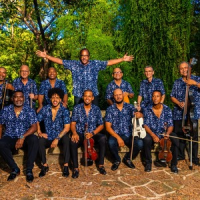Home » Jazz Musicians » Orquesta Aragon
Orquesta Aragon
This pillar of Cuban music got its start when double bass man Orestes Aragon Cantero debuted his charanga group in Cinefuegos. With violins, piano, flute, percussion, and vocal, the basic sound that has served the band ever since was already in place. But the name would evolve Ritmica de 39, to Ritmica Aragon, and finally, by the end of 1940, Orquesta Aragon.
A socialist before socialism was cool, Cantero rejected stardom, and the group he created became a monument to musical collectivism, with equal pay for all, and a sound that is all about unity and ensemble work. Cantero once said, "I want to found a musical family. I'm not looking for virtuoso players but musicians with human qualities." He got both, and his band worked the lively seaside scene in Cinefuegos year after year.
Cantero succumbed to a serious lung infection in 1948. Forced to retire, he turned leadership over to Rafael Lay who had played violin in the band since the age of 13. Just 20, Lay soon brought the band to play its first Havana gigs. This was a bold move for a band from the provinces, but Aragon's timing was good. In 1953, cha-cha overtook the mambo as the hot genre, and Aragon won a recording contract with RCA Victor and began making hit records.
1954 brought a new force to the band in the form of flautist and gifted composer Richard Egües. Among his many hits was El Bodeguero (The Grocer) picked up by Nat King Cole. Aragon's cha-cha sound went international, and the band toured the United States, Panama and Venezuela, until the dawn of Cuba's revolution, and subsequent isolation, in 1959.
The 1980s brought troubles for the band. Rafael Lay died in a car accident in 1982, and then a number of veterans, including Richard Egües and bass man Orestes Varona, retired. Following the musical explosions that went on in Cuba during the 1990s, the band regrouped under the leadership of Rafeal Lay Junior, returning to its roots, and to the recording studio to create rich new albums: Quien Sabe Sabe in 1997, La Charanga Eterna in 1999, and En Route in 2001. En Route received a Grammy nomination in the Tropical Music department, marking a new high water mark in a band history that just won't quit. Capable of appealing to a good three generations of Cuban music fans, Orquesta Aragon is now an institution, likely to outlive us all.
Source: Banning EyreTags
Orquesta Aragón at Brava Theater

by Harry S. Pariser
Orquesta Aragón Brava Theater jny:San Francisco, CA April 30, 2023 These days not many bands stick together for five years, let alone decades. The wonderful Orquesta Aragon has proven to be an exception to the rule since its founding in 1939 by bassist Orestes Aragón. Over the years, although personnel has shifted, the ensemble's original vibrant spirit has never dimmed, and its sound remains fresh, exciting and revitalizing. After Aragón suffered a serious ...
read more








